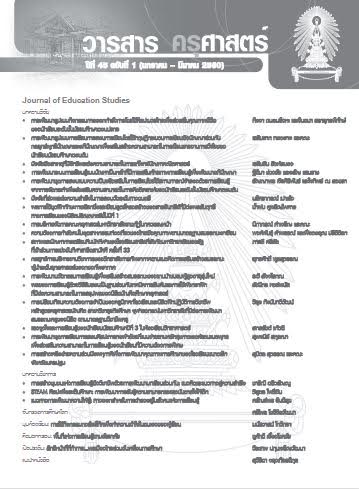การพัฒนาชุดการเรียนการสอนศิลปะการทอผ้าด้วยกี่แบบง่ายตามหลักสุขภาวะองค์รวมแนวพุทธเพื่อส่งเสริมความสามารถในการเรียนรู้ของนักเรียนที่มีความต้องการพิเศษ
Keywords:
ศิลปะการทอผ้าด้วยกี่แบบง่าย, สุขภาวะองค์รวมแนวพุทธ, นักเรียนที่มีความต้องการพิเศษ, SIMPLE LOOM WEAVING ART, BUDDHIST HOLISTIC HEALTH PRINCIPLE, SPECIAL NEEDS STUDENTSAbstract
งานวิจัยนี้มีวัตถุประสงค์เพื่อสร้างและศึกษาผลของการใช้ชุดการเรียนการสอนศิลปะการทอผ้าด้วยกี่แบบง่ายตามหลักสุขภาวะองค์รวมแนวพุทธเพื่อส่งเสริมความสามารถในการเรียนรู้ของนักเรียนที่มีความต้องการพิเศษ ใน 4 ด้าน ได้แก่ กายภาวนา ศีลภาวนา จิตตภาวนา และปัญญาภาวนา งานวิจัยนี้เป็นงานวิจัยกึ่งทดลองแบบกรณีศึกษา โดยศึกษาเด็กที่มีความต้องการพิเศษจำนวน 2 คน ซึ่งกำลังศึกษาในชั้นประถมศึกษาปีที่ 5 โรงเรียนรุ่งอรุณ ปีการศึกษา 2553 ระยะเวลาในการทดลอง 12 สัปดาห์ ผู้ให้ข้อมูลเพิ่มเติมได้แก่ ครูการศึกษาพิเศษ ครูประจำชั้น และผู้ปกครอง จำนวน 5 คน เก็บรวบรวมข้อมูลโดยใช้ แบบประเมินความสามารถในการเรียนรู้ สมุดบันทึกรายละเอียดความคิดเห็นและข้อสังเกต สมุดบันทึกสรุปการเรียนรู้หลังการทำงานของนักเรียน ร่วมกับการสัมภาษณ์เชิงลึกรายบุคคล วิเคราะห์ข้อมูลโดยการหาค่าร้อยละ และการวิเคราะห์เนื้อหา
ผลการวิจัย พบว่า ชุดการเรียนการสอนที่สร้างขึ้นประกอบ ขั้นตอนการสอน 4 ขั้น ได้แก่ ขั้นที่ 1 การทำกิจกรรมนำสมาธิแบบเคลื่อนไหว ขั้นที่ 2 การรับความรู้ ขั้นที่ 3 การฝึกฝนทักษะการทอผ้าและแก้ปัญหาที่พบ และขั้นที่ 4 การสรุปการเรียนรู้ หลังการใช้ชุดการเรียนการสอน พบว่า ความสามารถในการเรียนรู้ของนักเรียนกลุ่มอาการออทิสซึม ด้านจิตตภาวนาเป็นด้านที่พัฒนาได้ดีที่สุด ด้านศีลภาวนาเป็นด้านที่พัฒนาได้ยากที่สุด ส่วนนักเรียนที่มีความบกพร่องทางการเรียนรู้และสมาธิสั้น ด้านกายภาวนาเป็นด้านที่พัฒนาได้ดีที่สุด ด้านศีลภาวนาเป็นด้านที่พัฒนาได้ยากที่สุด การจัดการเรียนที่เหมาะสมและมีครูเข้าใจธรรมชาติการเรียนรู้ของนักเรียนเป็นปัจจัยภายนอกที่มีอิทธิพลต่อการเรียนรู้ของนักเรียนมากที่สุด
The purposes of this study were to construct and study the effects of using the simple loom weaving art instructional program based on Buddhist holistic health principle to develop the learning abilities of special needs students in four areas: physical development, moral development, emotional development and intellectual development. The research design was quasi-experimental design and case studies. The subject was two Prathom Suksa 5 special needs students, one with autism and one with learning disabilities and attention deficit hyperactivity disorder, studying at Roong Aroon School, academic year 2553. The duration of the experiment was 12 weeks. Five people were interviewed to additional information: students’ Special Education teacher, classroom teachers and parents. The data was collected by using the learning achievement evaluation form, teacher’s anecdotal observation and comment notebook, and individual student’s after-lesson learning summary booklet and in-depth interview form. The data was analyzed using percentage and content analysis.
The research finding was that 1) the developed Instructional Program consisted of 4 phases: Phase 1 Doing the movement meditation activity, Phase 2 Receiving the knowledge, Phase 3 Practicing weaving skills and solving arising problems, and Phase 4 Summarizing learning; 2) After using the Program, it was found that the area of learning abilities the student with autism developed the most was physical development, and the area he developed the least was moral development, while the student with learning disabilities and attention deficit hyperactivity disorder developed the most in physical development, and developed the least in moral development. The most important factors outside the learners influencing student’s learning were appropriate instructional organization and having a teacher who understood student’s learning needs




